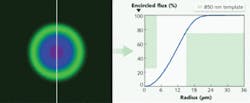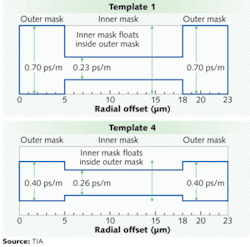FIBER-OPTIC TEST & MEASUREMENT: Gigabit Ethernet drives evolution of multimode fiber-optic specifications
DAVE KRITLER, CHRIS BROKKE, and PATRICK TOURREAU
For most of the 1990s the use of multimode optical fibers was limited to low-bitrate (10 to 100 Mbit/s) data networking applications. While most 50- and some 62.5-µm-core multimode fibers were known to be capable of much higher speeds, the LED transmitters used with the fibers were not. But later in the decade two seemingly unrelated developments promised to change the outlook for multimode fibers. The first was the formulation of a new local-area-network (LAN) design standard by the IEEE (www.ieee.org) known as “Gigabit Ethernet” (IEEE 802.3z).1 The objective of the standard was to define a range of single-mode fiber, multimode fiber, and even copper-based solutions for short-distance, gigabit data networking. The second development was the availability of short-wavelength (850 nm) vertical-cavity surface-emitting lasers (VCSELs)—light sources that could be modulated at high speed, yet were much less expensive to produce than long-wavelength distributed-feedback (DFB) or Fabry-Perot (FP) lasers.
Together, these developments would prove to be a “game changer” for multimode fibers and their manufacturers. Gigabit Ethernet provided a new market opportunity and low-cost VCSEL sources (coupled with low-cost silicon detectors) provided the means to move into the market. However, the multimode fiber/VCSEL solution would not be successful until some significant technical barriers were overcome.
Multimode obstacles
The challenges began when conventional multimode fibers were first tested with VCSEL-based transceivers to confirm gigabit performance. Tests showed that virtually all 50-µm-core-diameter multimode fibers could function up to the IEEE target link length of 550 m, but many 62.5 µm fibers could not—even those having relatively high bandwidth specifications. As a result, the maximum link length for 62.5 µm fibers was set at just 275 m. Disappointed by the finding, fiber manufacturers formed a task group within the Telecommunications Industries Association (TIA; Arlington, VA), with VCSEL and other suppliers, to determine why some high-bandwidth 62.5 µm fibers failed to perform with VCSEL sources, and to formulate a solution.
One of the first acts of the TIA Restricted Launch Bandwidth task group was to conduct a measurement round robin in which the bandwidth of a variety of 62.5 µm multimode fibers was characterized using test instrument laser launch conditions ranging from highly underfilled (a single-mode fiber launch) to the overfilled launch specified by bandwidth measurement standards. The results indicated that overfilled launch bandwidth, while an appropriate gauge of performance when fibers were used with LEDs, was not reliable for predicting the performance of fibers used with VCSELs. A new restricted-mode launch (RML) condition was required for measuring the bandwidth of multimode fibers to be used with underfilling VCSEL sources. After evaluating several methods for creating a RML, the task group decided that a specially designed 23.5 µm/0.205 numerical aperture (NA) graded-index fiber should be used as a launch conditioner for bandwidth test-set lasers. They also set a RML bandwidth specification of 385 MHz-km for Gigabit Ethernet–compliant fibers. The new RML measurement procedure and specification were published in a subsequent TIA standard, providing a path for 62.5 µm fibers to achieve the Gigabit Ethernet 550 m link-length target.2
The new RML test condition solved the problem of unreliable fiber-bandwidth specifications, but test methods and specifications were also needed to ensure that VCSEL launch characteristics remained compatible with RML-screened fibers. Unfortunately, there were no suitable measurement standards for characterizing the launch power distribution from a multimode fiber-pigtailed laser source. Conventional near-field, coupled-power-ratio (CPR) and mode-power-distribution (MPD) measurements were inadequate, which forced the task group to develop a new metric for characterizing a launch called “encircled flux.” Encircled flux provided a more comprehensive and more robust characterization of launch power. It quantified the fraction of the total fiber near-field power contained within a specific radius of the fiber core, obtained by integrating the fiber’s near field over both radius and angle. To rigorously describe a particular launch power distribution, multiple encircled flux values could be specified (see Fig. 1).
The 10 Gbit/s challenge
In 2001, with new test methods and specifications in place for RML bandwidth and VCSEL encircled flux, the TIA task group was finally able to ensure that both 50 and 62.5 µm multimode fibers could function reliably in Gigabit Ethernet links.3 But even before these specifications were finished, the IEEE Higher Speed Study Group (IEEE 802.3ae) began drafting the sequel to Gigabit Ethernet: a specification for 10 Gbit/s Ethernet LANs. The task group realized that this 10× increase in data rate meant more than just increasing the RML bandwidth specification. The only way to guarantee the performance of multimode fibers at 10 Gbit/s was to use intrinsically higher-bandwidth 50 µm fibers exclusively and control bandwidth-limiting pulse spreading in these fibers by controlling differential mode delay (DMD). To obtain peak performance, the fiber DMD would need to be matched to VCSEL encircled flux.
Fiber manufacturers were already familiar with DMD measurements since most used DMD as an internal process control tool. But the DMD measurement setups used for process feedback did not have the spatial or temporal resolution required to qualify next-generation 10 Gbit/s fibers. Faced with yet another measurement challenge the TIA Restricted Launch Task Group (now renamed the Task Group on the Modal Dependence of Bandwidth) set out to develop an improved DMD measurement method. The result was a technique that characterized DMD by stepping the output of a single-mode, fiber-pigtailed 850 nm pulsed laser across the core of the fiber under test in small (1 µm) increments. Exit pulses from the fiber at each radial launch position were collected by a detector and sampling oscilloscope.
After developing the “single-mode launch DMD” test method, the task group needed to decide how to specify DMD.4 Drawing on its experience with RML bandwidth and encircled flux, it arrived at two specification approaches. The first, a DMD mask (template) specification was relatively simple. Masks were defined that limited DMD to low values in regions of the fiber core where typical VCSELs would launch most of their power, but allowed higher DMD in regions where relatively little power would be launched. Several DMD masks were developed to give manufacturers the ability to trade higher DMD in the low-power regions for lower DMD in the high-power regions (see Fig. 2).The development of a more precise DMD measurement method and the creation of DMD mask and minEMBc fiber specifications enabled the production of multimode fibers with performance that few would have imagined just five years earlier. Yet, with relatively minor tuning of the encircled-flux specifications for 10 Gbit/s VCSELs, the TIA task group had developed all the test procedures and product specifications necessary to guarantee 10 Gbit/s data transmission over multimode fiber links up to 300 m long.
After years of diligent effort, the TIA task group had finally accomplished what it had set out to do. It had proved that multimode fiber and short-wavelength VCSEL-based transceivers could not only be the most cost-effective solution for short-distance, high-bitrate data links, but they could perform reliably as well. Based on subsequent adoption by the organizations behind Gigabit Ethernet, Fibre Channel, and Infiniband, the group apparently made its case. And, based on recent market forecasts for multimode data link components, they have convinced the broader market as well.
Test instrumentation
As the primary supplier of testing solutions to optical fiber and cable manufacturers, Photon Kinetics (Beaverton, OR) is actively involved with TIA and IEC fiber measurement standards development. Two products of its past involvement are the 2500 Optical Fiber Analysis System, a comprehensive test system for multimode bandwidth and DMD, and the 2440 Launch Analyzer, a next-generation instrument for encircled-flux characterization. More recent standards involvement has resulted in an improved, ultra-high-resolution (Ti:sapphire laser) DMD option for the 2500 to enhance measurement of newly standardized OM4 multimode fiber, and new encircled-flux capability for the 2440 that enables characterization of optical loss test set sources in accordance with current TIA and IEC standards.
REFERENCES
- IEEE Standard for Information Technology—Telecommunications and information exchange between systems—Local and metropolitan area networks—Specific requirements Part 3: Carrier sense multiple access with Collision Detection (CSMA/CD) Access Method and Physical Layer Specifications, Standard 802.3-2008 (December 2008).
- TIA TSB-62-20 Enhanced Bandwidth Performance over Laser-Based, Multimode Fiber Local Area Networks (February 2001).
- ANSI/TIA/EIA FOTP-204 Measurement of Bandwidth on Multimode Fiber, also published by IEC as IEC 60793-1-41 and ANSI/TIA FOTP-203 Light Source Encircled Flux Measurement Method, also published by IEC as IEC 61280-1-4 (December 2000).
- TIA FOTP-220 Differential Mode Delay Measurement of Multimode Fiber in the Time Domain, also published as IEC 60793-1-49 (January 2003).
Dave Kritler is marketing manager, and Chris Brokke and Patrick Tourreau are measurement engineers at Photon Kinetics, 9305 SW Gemini Drive, Beaverton, OR 97008; e-mail: [email protected]; www.photonkinetics.com.


